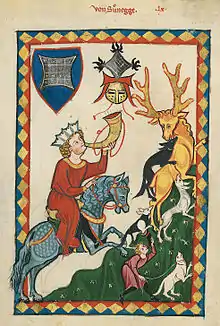Conrad I of Sanneck
Conrad I of Sanneck (German: Conrad von Sanneck, Slovene: Konrad Žovneški; ? – before 1255), Lord of Žovnek (Sanneck, in German), was a free noble in the March of Savinja in the Holy Roman Empire, in what is now Slovenia. He was an ancestor of the House of Celje, founded by his grandson Frederick.
Conrad of Sanneck | |
|---|---|
 "The One from Sanneck" (der von Sounegge) from Codex Manesse is generally considered as a depiction of Conrad I. | |
| Lord of Žovnek | |
| Reign | around 1286 - 1316 |
| Predecessor | Gebhard II of Sanneck |
| Successor | Liutpold III of Sanneck |
| Born | Žovnek Castle |
| Noble family | House of Sanneck |
| Issue | |
| Father | Gebhard II of Sanneck |
He was born to the free noble (roughly equivalent to a baron) Gebhard II of Sanneck. Little is known of his youth. He florished between 1220 and 1241, when his name is present in various sources,[1] showing that he was the owner of large allods in the Savinja Valley, then part of the March of Carniola. In 1237, the Patriarch of Aquileia Berthold of Andechs-Merania invested him with several fiefs in Carniola and in the Windic March.[2] Sources show that Conrad had a relatively large number of vassals, among whom the Auersperg family.[3]
It was Conrad who first used the traditional coat-of-arms of the House of Sanneck, two red stripes on a silver shield.[4]
Conrad was mentioned by the minnesanger Ulrich von Liechtenstein in his Frauendienst as a participant of the tournament in Friesach in Carinthia.[5] Conrad very likely wrote poetry himself, being considered the same person as "the Knight from Sanneck" mentioned in the famous Liederhandschrift (book of poetry), known as the Codex Manesse.[6][7]
Family
Conrad married the noblewoman Sophie of Pfannberg-Peggau. They had six children:[8][9]
- Conrad II of Sanneck
- Liutpold III of Sanneck
- Gebhard III of Sanneck
- Ulrich of Sanneck, who eventually became his father's sole heir
- Sophia
- Gertrud
References
- Fugger Germadnik Romanda et al. (2001): Razstava Grofje Celjski (1999; Celje). Celje, Pokrajinski muzej Celje, p. 13.
- Habjan Vlado (1997). Mejniki slovenske zgodovine. Ljubljana, Založba 2000, p. 53.
- Komac Andrej (2006): Od mejne grofije do dežele: Ulrik III. Spanheim in Kranjska v 13. Stoletju. Miha Kosi, ed. Ljubljana, Zgodovinski inštitut Milka Kosa ZRC SAZU.
- Fugger Germadnik Romanda et al. (2001): Razstava Grofje Celjski (1999; Celje). Celje, Pokrajinski muzej Celje, pp. 12, 17, 35.
- Grdina Ivan (1994). Celjski knezi v Evropi. Celje, Fit-Media. Str. IV.
- Fugger Germadnik Romanda et al. (2001): Razstava Grofje Celjski (1999; Celje). Celje, Pokrajinski muzej Celje, p. 11.
- Orožen Janko (1971): Zgodovina Celja in okolice, 1. Del. Iz: Celjski zbornik. Celje, Kulturna skupnost v Celju, p. 224.
- Habijan Vlado (1997). Mejniki slovenske zgodovine. Ljubljana, Društvo 2000, p. 66.
- Grdina Ivan (1994). Celjski knezi v Evropi.